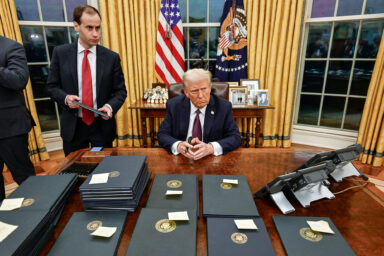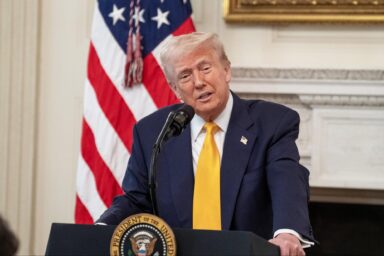A 1965 memo to Lyndon Baines Johnson discloses the link between CO2 emissions and climate change — showing federal climate action could have started decades sooner.
|
Listen To This Story
|
This story by Rebecca John was originally published by DeSmog and is part of Covering Climate Now, a global journalism collaboration strengthening coverage of the climate story.
•
A “Memorandum for the President” lists “the effects of carbon dioxide on climate” among the most pressing environmental problems of the day. It sounds like a message meant for US President Joe Biden. But the memo is dated January 13, 1965, and the president is the 36th of the United States of America, Lyndon B. Johnson.
This newly discovered document pinpoints the earliest-known moment that carbon-dioxide-induced climate change was brought to the attention of the highest levels of the US government — the President. It also adds to a growing body of evidence that decision-makers of the 1960s were concerned about potential climate change caused by the burning of fossil fuels, much earlier than previously thought.
The memo lists topics related to “Environmental Pollution” that the President’s Science Advisory Committee (PSAC) were considering as part of Johnson’s wider Great Society reform program intended to address the nation’s most urgent problems:
January 13, 1965, Memorandum For The President
“The Task Force on Environmental Pollution, which did such an outstanding job . . . is continuing, as a Panel to consider a series of questions related to Environmental Pollution. The topics presently under consideration include:
. . . The effects of carbon-dioxide on climate.”
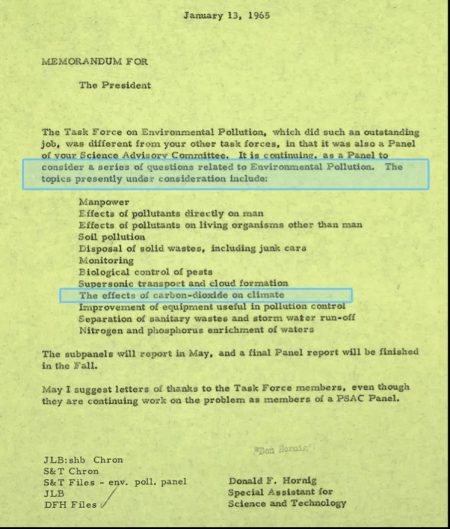
Photo credit: Read the entire document on DocumentCloud.
In recent years, experts and journalists have paid considerable attention to the November 1965 report that PSAC released, shining a light not only on the accuracy and prescience of the climate science of the mid-1960s, but also showing the degree to which scientists warned the political establishment about the potential future impacts of the use of fossil fuels.
However, the newly discovered Presidential Memorandum, along with other reports from the Department of Health, Education and Welfare (HEW) and the White House’s Environmental Task Force, add to our historical understanding of an early emerging consensus among scientists over the seriousness of the greenhouse effect of CO2, despite the fossil fuel industry and climate deniers’ attacks on this science in the years since. In addition, these documents — written a full 30 years before the Intergovernmental Panel on Climate Change’s (IPCC) Second Assessment Report confirming that fossil fuel use had increased the concentration of greenhouse gases in the atmosphere — demonstrate that the climate change problem was discussed more widely at the top levels of government, and to a greater extent, than previously thought.
Hopes for an Ambitious Environmental Program
Discovered in the Lyndon B. Johnson Presidential Library in Austin, Texas, the January 13, 1965, memo was sent by Johnson’s special assistant for science and technology, Donald Hornig.
Written exactly one week before Johnson’s second inauguration, Hornig’s memo outlines preparations for an ambitious environmental program. This would accompany other reforms envisioned by the new administration following Johnson’s landslide victory in the 1964 election.
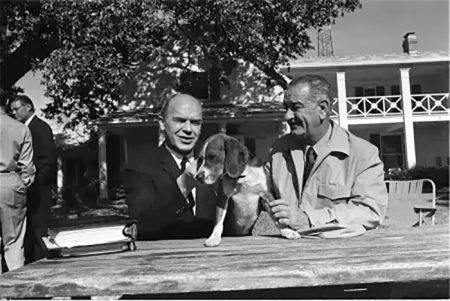
Photo credit: Lyndon B. Johnson Presidential Library
The internal White House memo provides evidence that the problem of climate change caused by the burning of fossil fuels worried US leaders almost a quarter of a century before oil and gas companies launched decades-long campaigns of climate science denial beginning in the late 1980s. It also illustrates the science-based approach the Johnson administration adopted toward the problem, in contrast to the politicization of climate change that followed in later years and persists to this day.
In the memo, Hornig suggested that Johnson send letters of thanks to the members of the Science Advisory Committee. A separate collection of documents held at the LBJ Library shows that Johnson sent these letters the following day, January 14, 1965, indicating that he read Hornig’s memo.
In the letters, Johnson expressed his gratitude for their service on the Task Force. He specifically referred to the “magnitude of the pollution problem,” and the “urgency of increased attention to prevention and abatement of pollution of our soils, air and waters.”
Johnson also voiced his belief that the nation had “an unparalleled opportunity to take some major steps toward creating the Great Society,” emphasizing that the committee members’ ideas and suggestions would be “of great help” in formulating his administration’s program “now and in the years ahead.”
CO2 and Climate Change
Prior to the January memo, the Task Force on Environmental Pollution had released a November 1964 report discussing the build-up of atmospheric carbon dioxide (CO2). “Our generation has altered the composition of the atmosphere on a global scale through the emission of radioactive material and a growing outpouring of carbon dioxide from the burning of fossil fuels,” it stated.

Photo credit: Read the entire document on DocumentCloud.
However, the November report had not detailed CO2’s potential to affect the earth’s climate. This information connecting CO2 with climate change, which first appeared in the January memo, seems to have entered the White House’s orbit via a different route: A report produced by the philanthropic organization, the Conservation Foundation.
“Implications of Rising Carbon Dioxide Content of the Atmosphere,” published by the Conservation Foundation in the fall of 1963, summarized a conference of experts organized by the foundation to discuss the issues surrounding the rising CO2 content of the air. It specifically outlined the potential impacts of CO2 emissions on the Earth’s climate, reporting that the continuing rise in atmospheric carbon dioxide was “likely to be accompanied by a significant warming of the surface of the earth, which by melting the polar ice caps would raise sea levels.”
Several months later, “Implications of Rising Carbon Dioxide” served as the main reference for a discussion of the climate impacts of CO2 in a chapter on “The Air Pollution Problem,” which HEW wrote as part of a 1964 report on national research priorities for the Interdepartmental Committee on Atmospheric Science (ICAS). ICAS in turn submitted its reports to the Federal Council for Science and Technology — which was led by Hornig, the author of the January 13, 1965, memo.
Hornig’s newly discovered memo shows that PSAC was also concerned with the climate impacts of CO2 emissions. So much so that, by July, the organization created a separate subpanel to address the problem. On July 30, 1965, Hornig wrote to Johnson’s chief domestic advisor, Joseph Califano stating, “A big PSAC study on Environmental Pollution is going forward,” and informed Califano that subpanels had been established to gather more information in certain key areas. These included the “‘Greenhouse’ effect of CO2.” Hornig told Califano that the PSAC panel would meet in August at Woods Hole in Falmouth, MA, and that he expected a draft of the final report “sometime this fall.”

Photo credit: Read the entire document on DocumentCloud.
Published in November 1965, PSAC’s report, “Restoring the Quality of Our Environment,” devoted an entire section to “Atmospheric Carbon Dioxide” in the form of an extended 22-page appendix.
Oceanographer and climate scientist Roger Revelle chaired the CO2 subpanel, which included Charles David Keeling, one of the experts who participated in the Conservation Foundation’s 1963 CO2 conference. The 22-page CO2 appendix referenced work by both Revelle and Keeling, along with numerous other scientists, as well as summarizing proceedings of the CO2 conference itself.
Devastating Consequences
The November 1965 PSAC report, “Restoring the Quality of Our Environment,” stated in no uncertain terms that burning fossil fuels was “measurably increasing” atmospheric CO2 levels, predicting with remarkable accuracy that by the year 2000 there would be a 25 percent increase in atmospheric CO2 compared to pre-industrial levels. It also emphasized that this increase in CO2 would likely affect the Earth’s climate, causing a parallel increase in average temperatures near the Earth’s surface. According to the report, other possible climatic effects of increased CO2 included the melting of the Antarctic ice-cap, sea-level rises, and warming of the oceans.
The report illustrates an emerging consensus among climate scientists that escalating CO2 emissions from burning fossil fuels would cause global temperatures to rise, resulting in changes to the earth’s climate. Although the precise level of this rise could not be specified, the report predicted an estimated range “between 0.6°C and 4°C” with increases expected to be more intense in different geographic places — for example, in the Earth’s polar regions. Up until that point, the authors wrote, humanity had been “unwittingly conducting a vast geophysical experiment.” After the publication of PSAC’s report, people would do so wittingly.
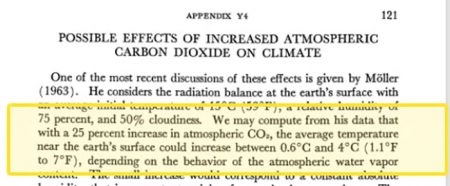
Photo credit: Read the entire document in DocumentCloud.
Current legal challenges to Big Oil use the argument that the companies knew about fossil fuels’ climate impact, lied about this impact, and continued to produce and promote the use of more fossil fuels. One defense that industry representatives have made is that they were acting in accordance with the uncertainties of the science of the time. However, these newly discovered documents show that the science, even at this early date, was far less uncertain than this defense attempts to portray it.
Because of its “general interest,” Johnson released the PSAC report and its Appendix on CO2 for publication. A White House press release dated November 6, 1965, summarized the report’s highlights and included the following information on CO2: “Carbon dioxide is being added to the earth’s atmosphere by the burning of coal, oil, and gas at the rate of 6 billion tons a year. By the year 2000 there will be about 25 percent more carbon dioxide in our atmosphere than at present.” Johnson also released an accompanying statement from his Hill Country ranch, known as the Texas White House. “Pollution is now one of the most pervasive problems of our society,” he declared, announcing his intention “to give high priority to increasing the numbers and quality of the scientists and engineers working on problems related to the control and management of pollution.”
While these statements emphasized the role of burning fossil fuels in the rise of atmospheric CO2, neither mentioned its possibly devastating consequences for life on Earth. The January 13, 1965, memo, however, clearly refers to “the effects of carbon-dioxide on climate,” demonstrating that, for the first time, the potential climate impact of increased atmospheric CO2 was communicated at the highest level.
Nevertheless, following the publication of the November PSAC report, these revelations over CO2 and climate reached a much wider audience than the January 13, 1965 memo, via newspaper articles across the US. On Sunday, November 29, 1965, the Miami Herald’s headline blared, “Air Pollution: Will it Destroy Our Children?” It reported that increasing CO2 could raise average air temperatures, with the result that “polar ice could melt and the oceans rise to swallow up our cities.” The Herald emphasized that this wasn’t “idle speculation or science fiction” but was based on warnings sounded by “reasonable scientists in and out of government.”
Probable Opposition
It’s one of the ironies of history that Johnson should be the first president to be informed of CO2-induced climate change and approve its inclusion in the federal environmental agenda. The very first contributors to his 1937 inaugural Congressional campaign to represent Texas in the House were Humble Oil (later Exxon) and the Magnolia Oil Company (later Mobil) — both now ExxonMobil, historically one of the largest bankrollers of global climate denial, with its legacy persisting to this day.
This campaign of denial, however, may not have come as a great surprise to members of the Task Force on Environmental Pollution. While the environmental reforms of Johnson’s Great Society program could expect “strong bipartisan support” in the House and Senate, the Task Force predicted that the administration could encounter “Substantial industry opposition … both overt and covert.” According to the Task Force, groups such as the National Association of Manufacturers (NAM), the Manufacturing Chemists Association, the US Chamber of Commerce, and the Automobile Manufacturers Association “will oppose any strengthening of Federal controls, although they will support research and limited State grant programs.”
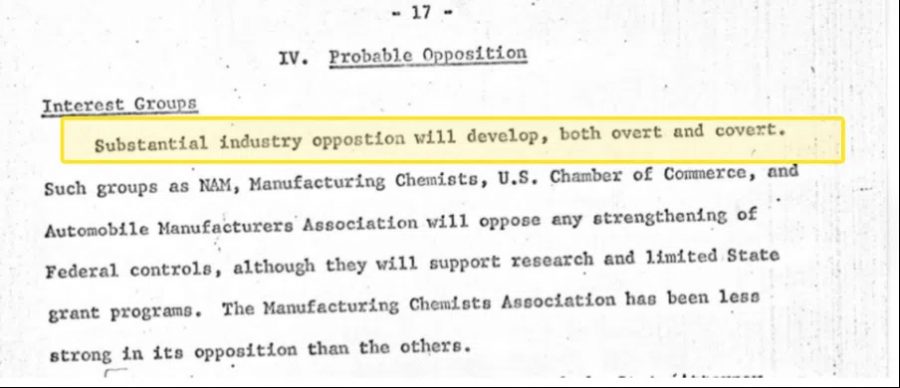
Photo credit: Read the entire document on DocumentCloud.
In line with this prediction, by 1965 this “Probable Opposition” of interest groups was, in fact, already at work, attempting to influence and constrain efforts to combat air pollution — an attempt that would take on a growing significance and impact in the decades ahead. These Johnson Administration documents convey an urgency and seriousness of approach that stand in sharp contrast to major oil companies’ later public stance in response to the science of fossil-fuel-induced climate change — a stance overwhelmingly characterized by denial and deception. With today’s global temperatures 1. 2 degrees Celsius higher than pre-industrial times increasing climate instability (flooding, droughts, wildfires, extreme heat and cold events), these 1960s documents, created prior to the industry’s assault on science and extensive lobbying campaigns, are powerfully significant. Building on the insights already gained by the rediscovery of the PSAC report, they further illustrate that effective and timely action against climate change might have been taken while its impacts were still an abstract notion, rather than a physical reality.



